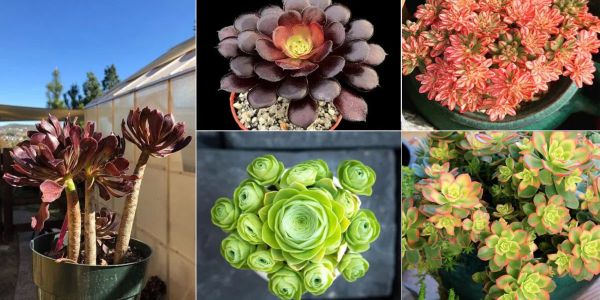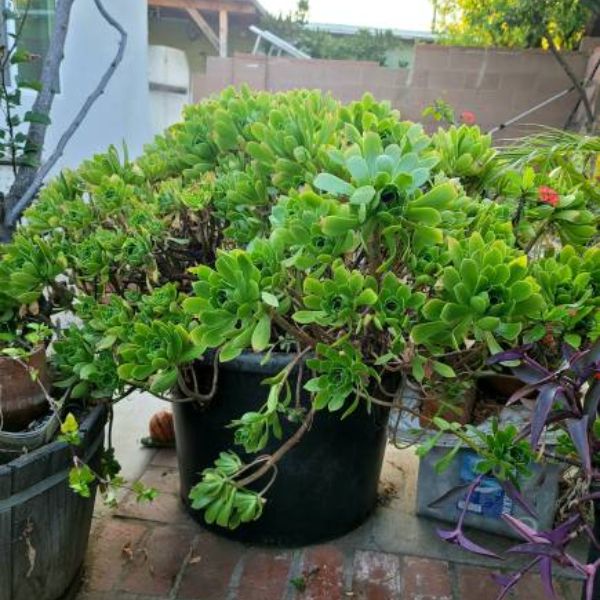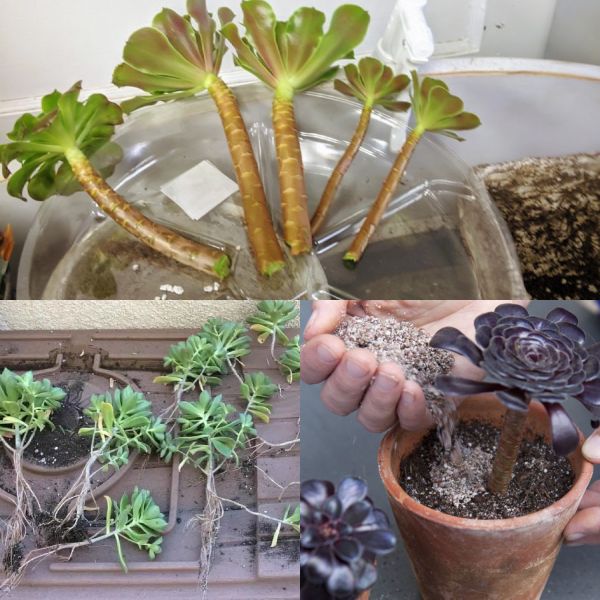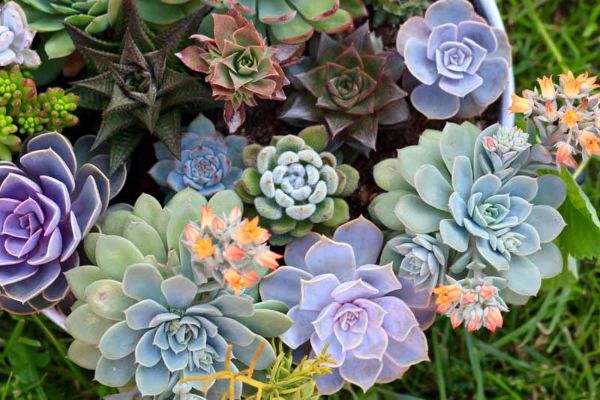Aeonium, also called Tree Houseleek, is a succulent plant popular for its attractive fleshy rosette-shaped foliage. It belongs to the Crassulaceae family and is native to North Africa and nearby islands including the Canary Islands, Cape Verde Islands, and Madeira. The leaves come in shades of solid green, green variegated with creamy yellow, bronzy purple, or dark purple. It can grow up to 3 feet tall and produces flower stalks about 8 inches long in late winter or spring. At the end of these stalks, you will see cone-shaped clusters of flowers. The small, star-shaped flowers can be creamy white, yellowish, golden, pink, or red.
This plant is great for beginners because it is easy to take care of. Whether you grow plants inside or outside, Aeonium can add a special touch to your garden. This guide will show you how to grow and care for Aeonium so your plants stay healthy and make your space more beautiful.
Descriptions of Plants
Plant Type: Succulent
Scientific name: Aeonium spp.
Common name: Aeonium, Tree Houseleek
Family: Crassulaceae
Genus: Aeonium, Webb & Berthel
Season: Winter, Spring
Native Area: Canary Islands, North Africa, Madeira
Toxicity: Non-toxic
Varieties of Aeonium
Aeonium is a group of about 35 species of small to medium-sized subtropical succulents. Some popular species and varieties include:
Aeonium arboreum
Aeonium arboreum is an evergreen succulent plant. It has shiny, fleshy green leaves that look like small spatulas. In late winter to early spring, it also produces bright golden clusters of small, star-shaped flowers. It grows up to 6 feet tall in the garden or 3 feet tall in containers. This plant thrives in sandy, dry to medium moisture, well-drained soils. Similarly, it prefers bright sunlight but can also grow in light shade and poor soils. While it can tolerate drought, Aeoniums need more regular watering than other succulents because they have small, shallow roots.

Aeonium davidbramwelli ‘Sunburst’
This variety is a shorter plant, growing 1 to 2 feet tall, with rosettes up to 1 foot wide. Its leaves have pale yellow, white, and green stripes with pink tips. It is likely a hybrid with Aeonium arboreum. Plant Sunburst in full sun or bright shade in well-drained soil, and water it occasionally. It doesn’t tolerate cold temperatures and can’t survive much below 28°F.
Aeonium arboreum ‘Atropurpureum’
Atropurpureum features eye-catching rosettes of colorful leaves with branched stems that can grow up to 3 feet tall. The leaves change color from reddish-green to deep reddish-purple throughout the season. In late spring, it also produces bright yellow, star-shaped flowers in large clusters.
Aeonium arboreum ‘Zwartkop’ or ‘Black Rose’
This succulent is a branching shrub featuring dark, deep burgundy, or almost black foliage. The leaves are quite large with spoon-shaped and narrower than those of Atropurpureum. It can grow up to 3 feet tall and produces yellow flowers in the summer.
Growing and Caring Tips of Aeonium
Aeoniums are easy to grow if you know the right timing and conditions. They grow best in spring when they make new leaves and become more adaptable to changes in their environment.
Lighting: Aeonium plants require bright, indirect light for at least 6 hours a day. So, choose a location that receives full to partial sun. Direct sunlight can harm the leaves, causing white or brown spots on the tips. Further, they can handle some shade if it is very hot or desert conditions.
Soil Preparations: Whether you are growing indoors or outdoors, Aeoniums prefers well-draining soil. Keep the soil moist but not waterlogged. Otherwise, root rot can develop. You can improve any regular potting soil by mixing perlite or sand into it for better drainage.

Watering: Water your Aeoniums moderately and let the soil dry out between waterings. Although these plants do require a decent amount of moisture compared to other succulents, the root rot will develop if there is too much water or if the soil is constantly wet.
Temperature and Humidity: These plants prefer a Mediterranean climate, which means not too hot, not too cold, and not too dry. The Aeoniums will appreciate daytime temperatures from 65-75°F while the nighttime temperatures remain above 50°F. In the same way, they can tolerate low to moderate humidity.
Fertilizer: During the growing season, feed Aeoniums with a half-strength balanced, water-soluble fertilizer. While the young plants might need fertilizer every month older plants may only need it once in the spring. Similarly, avoid fertilizing when the plants are dormant.
Pruning: Pruning helps Aeoniums grow fuller and bushier. To promote more branches, you can pinch or trim the tips of the stems. Do cut back long, leggy stems to keep the plant nice looking. Also, always remove dead or stretched-out growth to make the plant look better.
Pests and Diseases: Aeonium may be infested by pests such as aphids, mites, scales, and mealybugs. Always be on the lookout for your plants because these insects can damage them by feeding on sap. Rinse the plant with water or mild insecticidal soap and remove pests. Additionally, Aeoniums can rot if the root has become too wet or if the soil doesn’t drain well. Prevent waterlogged soil with good drainage to prevent fungal problems.
What are the methods of propagation for Aeonium?
Aeonium plants can be propagated either from seed, division of those that form offsets or side rosettes, or by cuttings. Propagating these plants lets you expand your garden and keep the special traits of your favorite plants. Whether using leaf cuttings, offsets, or other methods, propagating Aeoniums is a fun way to grow more succulents.
Seedling
You can also grow Aeoniums from seeds. However, many prefer to propagate this plant through vegetative methods. First of all, gather seeds from the mature head of the flower after they get dry. Sow these seeds in a very well-drained soil. Maintain the soil moist but not water-logged till the germination of seeds. Likewise, ensure adequate warmth and light to promote seed growth. After the seeds germinate, you can adjust the care routine to support the young plants as they develop.
Offsets or Pups
Aeoniums frequently develop offsets or pups around the base of the main rosette. Many types of aeoniums form offsets or pups at the base of the main rosette. For propagation, gently remove the offset from the parent plant, making sure it has roots. Place the offset in a new pot with added well-draining soil. Water it lightly and keep it in bright indirect light while getting established.

Leaf Cuttings
Spring and summer are the best times to take cuttings since the plant is in its active growth phase. Here are the easiest steps to propagate these succulents from leaves:
Step 1: Carefully cut a rosette from the parent plant using a clean, sharp knife at an angle of 45 degrees.
Step 2: Allow the cut end to dry for up to three days. Letting the cut end dry out forms a callus that helps prevent rot by keeping out moisture.
Step 3: Plant directly into sharp sand or a well-drained potting mix after drying.
Step 4: Lightly water the newly planted leaf and place it in a bright area with indirect lighting. Over time, you will begin to notice the roots growing off of the leaf.
Also read, How to Grow and Care for Goldfish Plant! Know Its Types, Propagation Tips, and Diseases!
Frequently Asked Questions
1. What is an Aeonium?
Aeonium belongs to the family Crassulaceae and is a succulent plant also referred to as Tree Houseleek. Plants are native to North Africa, the Canary Islands, the Cape Verde Islands, and Madeira. It has very beautiful rosettes in different colors.
2. How to care for Aeonium plants?
Aeoniums require bright, indirect light for at least 6 hours a day. They require well-draining soil with moderate watering. Allow the soil to dry a bit between waterings. Avoid temperatures higher than 75°F by day and lower than 50°F by night. Other care includes occasional feeding with a balanced fertilizer in the growing season and pruning for them to look fuller.
3. What are the common pests and diseases affecting Aeoniums?
Aeonium may be infested by pests such as aphids, mites, scales, and mealybugs. So, check for pests regularly, and make sure that plants have good drainage to avoid fungal issues.
4. How to propagate Aeonium plant?
Aeonium can be propagated by seeds, offsets, or leaf cuttings. In the case of offsets, remove them from the main plant, plant them in well-draining soil, and let them grow. For leaf cuttings, allow the cut end to dry for a few days before planting in a well-drained mix. Seeds should be sown in damp, well-draining soil and kept in a warm, bright location.
5. Which are some popular Varieties of Aeonium?
Some popular Aeonium varieties include Aeonium arboreum, Aeonium davidbramwelli ‘Sunburst,’ Aeonium arboreum ‘Atropurpureum’, and Aeonium arboreum ‘Zwartkop’.
